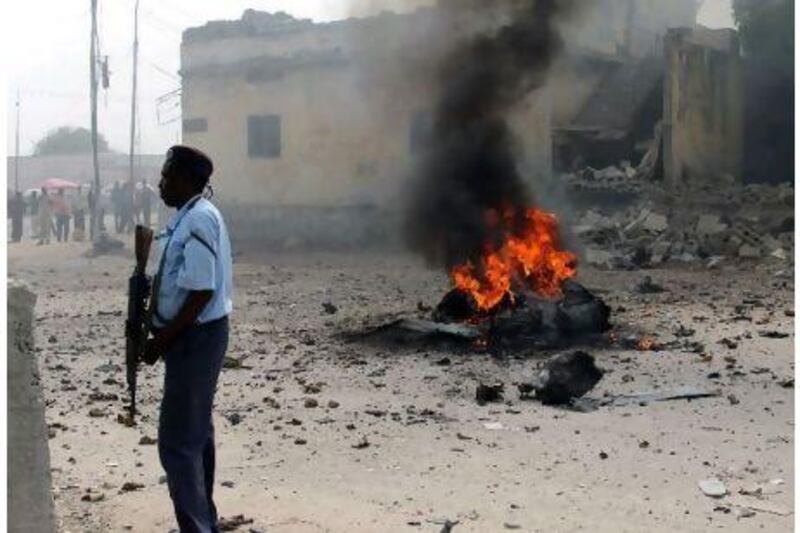NAIROBI // Five months after withdrawing from Mogadishu, the Islamist rebel group Al Shabab has adapted a new strategy to wreak havoc on the Somali capital, according to the African Union peacekeeping mission deployed there. In the past month, roadside bomb attacks have increased dramatically, compounding the insecurity of a city used to street-by-street urban warfare.
Rebel-planted improvised explosive devices (IEDs) have hit high-profile sites in the past week, including a junction near the recently opened Turkish embassy and a children's hospital, and killed dozens of Somalis.
"Al Shabab made it clear [back in August] that they were not withdrawing in terms of defeat, and they were going to resort to different tactics," said Eloi Yao, spokesman of the African Union mission in Somalia (Amisom), in a phone interview. "We have seen that [an increase in] suicide bombs, IED explosions. They have blended into the population to cause other damages and fear."
Although Al Shabab has used IEDs in the past, analysts have said they have become the group's main weapon in the capital. For months, the rebel group fought in Mogadishu for territorial gains measured in mere metres. They have now been able to disrupt the Somali capital at a far lower cost.
Amisom said it would adjust its tactics to counter those of the rebels. But analysts pointed out that the peacekeepers are dogged by poor equipment and the sort of high-power reconnaissance that would improve its ability to thwart attacks. The force lacks air support, for example, and has no access to a helicopter for surveillance or medical evacuation.
In August, the more than 9,000-strong Amisom force celebrated a small victory when Al Shabab announced it would cede control of the capital. Once the rebels withdrew, areas that were once off limits for government officials, diplomatic personnel and aid workers were brought under the peacekeepers' control. Business started operating again, apartments were repainted and humanitarian operations expanded.
"Al Shabab faced increasing pressure from a growing Amisom force in Mogadishu [in August]," said David Shinn, the former US ambassador to Somalia. "In fact, it was losing territory. I believe Al Shabab concluded that it was less costly to pull out of town."
The reprieve proved timely. Nearly all of southern Somalia was in famine, with tens of thousands of fleeing their homes every week in search of assistance. By the beginning of September, aid agencies warned that nearly 750,000 million Somalis were at risk of death from starvation. By early December, that number had fallen to 250,000.
Now, however, aid workers worry that the minor gains they have made in Mogadishu in relieving hunger could be reversed by Al Shabab's tactics. With block-to-block combat, it was possible to draw battle lines in the capital. IED attacks mean that nowhere in the capital can be considered safe.
"Al Shabab made a tactical withdrawal from Mogadishu, parts of which are still contested. Access has improved, but it's still a very difficult operating environment," explained Mark Bowden, the UN's resident and humanitarian coordinator for Somalia. "The number of IEDs has risen and costs of operation are still significantly higher than anywhere else."
The deterioration in Mogadishu security comes during a time when the news was already grim for humanitarian assistance across Somalia.
The UN Mission in Somalia asked the international community on Tuesday for US$1.5 billion (Dh5.5bn) to fund humanitarian operations in the coming year. It said 3 million people - or about one-third of Somalia's population - remains dependent on assistance for survival and 250,000 people face imminent death to famine conditions.
In late November, Al Shabab announced that it was banning 16 relief organisations, including five UN agencies, from operating in the parts of southern Somalia that it controls.
While the UN operation has said it was still assessing the effect of the ban, the announcement threatens to reignite the crisis among communities already teetering on the edge of starvation. Two months of torrential rains in the south only began to slacken last week. Fields are unplanted, and the farmers who tilled them have fled.
Operations by the Kenyan military in southern Somalia have also hindered access, the UN said. In mid-October, that country's troops crossed the border in hopes of pushing Al Shabab deeper into Somali territory.
Although the Kenyan army was offering assistance to the communities where it was operating, the fighting has continued to encourage villagers to flee.
[ foreign.desk@thenational.ae ]
Al Shabab uses Twitter in propaganda fight, page a18





